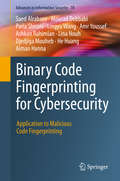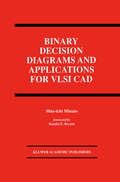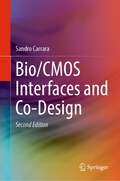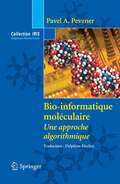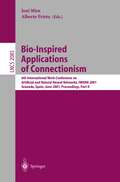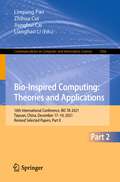- Table View
- List View
BIM Teaching and Learning Handbook: Implementation for Students and Educators
by M. Reza Hosseini Farzad Khosrowshahi Ajibade Aibinu Sepehr AbrishamiThis book is the essential guide to the pedagogical and industry-inspired considerations that must shape how BIM is taught and learned. It will help academics and professional educators to develop programmes that meet the competences required by professional bodies and prepare both graduates and existing practitioners to advance the industry towards higher efficiency and quality. To date, systematic efforts to integrate pedagogical considerations into the way BIM is learned and taught remain non-existent. This book lays the foundation for forming a benchmark around which such an effort is made. It offers principles, best practices, and expected outcomes necessary to BIM curriculum and teaching development for construction-related programs across universities and professional training programmes. The aim of the book is to: Highlight BIM skill requirements, threshold concepts, and dimensions for practice; Showcase and introduce tried-and-tested practices and lessons learned in developing BIM-related curricula from leading educators; Recognise and introduce the baseline requirements for BIM education from a pedagogical perspective; Explore the challenges, as well as remedial solutions, pertaining to BIM education at tertiary education; Form a comprehensive point of reference, covering the essential concepts of BIM, for students; Promote and integrate pedagogical consideration into BIM education. This book is essential reading for anyone involved in BIM education, digital construction, architecture, and engineering, and for professionals looking for guidance on what the industry expects when it comes to BIM competency.
The Biml Book: Business Intelligence and Data Warehouse Automation
by Andy Leonard Scott Currie Jacob Alley Martin Andersson Peter Avenant Bill Fellows Simon Peck Reeves Smith Raymond Sondak Benjamin Weissman Cathrine WilhelmsenLearn Business Intelligence Markup Language (Biml) for automating much of the repetitive, manual labor involved in data integration. We teach you how to build frameworks and use advanced Biml features to get more out of SQL Server Integration Services (SSIS), Transact-SQL (T-SQL), and SQL Server Analysis Services (SSAS) than you ever thought possible.The first part of the book starts with the basics—getting your development environment configured, Biml syntax, and scripting essentials.Whether a beginner or a seasoned Biml expert, the next part of the book guides you through the process of using Biml to build a framework that captures both your design patterns and execution management. Design patterns are reusable code blocks that standardize the approach you use to perform certain types of data integration, logging, and other key data functions. Design patterns solve common problems encountered when developing data integration solutions. Because you do not have to build the code from scratch each time, design patterns improve your efficiency as a Biml developer.In addition to leveraging design patterns in your framework, you will learn how to build a robust metadata store and how to package your framework into Biml bundles for deployment within your enterprise.In the last part of the book, we teach you more advanced Biml features and capabilities, such as SSAS development, T-SQL recipes, documentation autogeneration, and Biml troubleshooting.The Biml Book:Provides practical and applicable examplesTeaches you how to use Biml to reduce development time while improving qualityTakes you through solutions to common data integration and BI challengesWhat You'll LearnMaster the basics of Business Intelligence Markup Language (Biml)Study patterns for automating SSIS package generationBuild a Biml FrameworkImport and transform database schemasAutomate generation of scripts and projectsWho This Book Is ForBI developers wishing to quickly locate previously tested solutions, Microsoft BI specialists, those seeking more information about solution automation and code generation, and practitioners of Data Integration Lifecycle Management (DILM) in the DevOps enterprise
Bin-Picking: New Approaches for a Classical Problem (Studies in Systems, Decision and Control #44)
by Dirk BuchholzThis book is devoted to one of the most famous examples of automation handling tasks – the “bin-picking” problem. To pick up objects, scrambled in a box is an easy task for humans, but its automation is very complex. In this book three different approaches to solve the bin-picking problem are described, showing how modern sensors can be used for efficient bin-picking as well as how classic sensor concepts can be applied for novel bin-picking techniques. 3D point clouds are firstly used as basis, employing the known Random Sample Matching algorithm paired with a very efficient depth map based collision avoidance mechanism resulting in a very robust bin-picking approach. Reducing the complexity of the sensor data, all computations are then done on depth maps. This allows the use of 2D image analysis techniques to fulfill the tasks and results in real time data analysis. Combined with force/torque and acceleration sensors, a near time optimal bin-picking system emerges. Lastly, surface normal maps are employed as a basis for pose estimation. In contrast to known approaches, the normal maps are not used for 3D data computation but directly for the object localization problem, enabling the application of a new class of sensors for bin-picking.
Binary Code Fingerprinting for Cybersecurity: Application to Malicious Code Fingerprinting (Advances in Information Security #78)
by Saed Alrabaee Mourad Debbabi Paria Shirani Lingyu Wang Amr Youssef Ashkan Rahimian Lina Nouh Djedjiga Mouheb He Huang Aiman HannaThis book addresses automated software fingerprinting in binary code, especially for cybersecurity applications. The reader will gain a thorough understanding of binary code analysis and several software fingerprinting techniques for cybersecurity applications, such as malware detection, vulnerability analysis, and digital forensics. More specifically, it starts with an overview of binary code analysis and its challenges, and then discusses the existing state-of-the-art approaches and their cybersecurity applications. Furthermore, it discusses and details a set of practical techniques for compiler provenance extraction, library function identification, function fingerprinting, code reuse detection, free open-source software identification, vulnerability search, and authorship attribution. It also illustrates several case studies to demonstrate the efficiency, scalability and accuracy of the above-mentioned proposed techniques and tools. This book also introduces several innovative quantitative and qualitative techniques that synergistically leverage machine learning, program analysis, and software engineering methods to solve binary code fingerprinting problems, which are highly relevant to cybersecurity and digital forensics applications. The above-mentioned techniques are cautiously designed to gain satisfactory levels of efficiency and accuracy. Researchers working in academia, industry and governmental agencies focusing on Cybersecurity will want to purchase this book. Software engineers and advanced-level students studying computer science, computer engineering and software engineering will also want to purchase this book.
Binary Decision Diagrams: Theory and Implementation
by Rolf Drechsler Bernd BeckerFor someone with a hammer the whole world looks like a nail. Within the last 10-13 years Binar·y Decision Diagmms (BDDs) have become the state-of-the-art data structure in VLSI CAD for representation and ma nipulation of Boolean functions. Today, BDDs are widely used and in the meantime have also been integrated in commercial tools, especially in the area of verijication and synthesis. The interest in BDDs results from the fact that the data structure is generally accepted as providing a good compromise between conciseness of representation and efficiency of manipulation. With increasing number of applications, also in non CAD areas, classical methods to handle BDDs are being improved and new questions and problems evolve and have to be solved. The book should help the reader who is not familiar with BDDs (or DDs in general) to get a quick start. On the other hand it will discuss several new aspects of BDDs, e.g. with respect to minimization and implementation of a package. This will help people working with BDDs (in industry or academia) to keep informed about recent developments in this area.
Binary Decision Diagrams and Applications for VLSI CAD (The Springer International Series in Engineering and Computer Science #342)
by Shin-ichi MinatoSymbolic Boolean manipulation using binary decision diagrams (BDDs) has been successfully applied to a wide variety of tasks, particularly in very large scale integration (VLSI) computer-aided design (CAD). The concept of decision graphs as an abstract representation of Boolean functions dates back to the early work by Lee and Akers. In the last ten years, BDDs have found widespread use as a concrete data structure for symbolic Boolean manipulation. With BDDs, functions can be constructed, manipulated, and compared by simple and efficient graph algorithms. Since Boolean functions can represent not just digital circuit functions, but also such mathematical domains as sets and relations, a wide variety of CAD problems can be solved using BDDs. `Binary Decision Diagrams and Applications for VLSI CAD provides valuable information for both those who are new to BDDs as well as to long time aficionados.' -from the Foreword by Randal E. Bryant. `Over the past ten years ... BDDs have attracted the attention of many researchers because of their suitability for representing Boolean functions. They are now widely used in many practical VLSI CAD systems. ... this book can serve as an introduction to BDD techniques and ... it presents several new ideas on BDDs and their applications. ... many computer scientists and engineers will be interested in this book since Boolean function manipulation is a fundamental technique not only in digital system design but also in exploring various problems in computer science.' - from the Preface by Shin-ichi Minato.
Binary Neural Networks: Algorithms, Architectures, and Applications (Multimedia Computing, Communication and Intelligence)
by Baochang Zhang Sheng Xu Mingbao Lin Tiancheng Wang David DoermannDeep learning has achieved impressive results in image classification, computer vision, and natural language processing. To achieve better performance, deeper and wider networks have been designed, which increase the demand for computational resources. The number of floatingpoint operations (FLOPs) has increased dramatically with larger networks, and this has become an obstacle for convolutional neural networks (CNNs) being developed for mobile and embedded devices. In this context, Binary Neural Networks: Algorithms, Architectures, and Applications will focus on CNN compression and acceleration, which are important for the research community. We will describe numerous methods, including parameter quantization, network pruning, low-rank decomposition, and knowledge distillation. More recently, to reduce the burden of handcrafted architecture design, neural architecture search (NAS) has been used to automatically build neural networks by searching over a vast architecture space. Our book will also introduce NAS and its superiority and state-of-the-art performance in various applications, such as image classification and object detection. We also describe extensive applications of compressed deep models on image classification, speech recognition, object detection, and tracking. These topics can help researchers better understand the usefulness and the potential of network compression on practical applications. Moreover, interested readers should have basic knowledge of machine learning and deep learning to better understand the methods described in this book. Key Features • Reviews recent advances in CNN compression and acceleration • Elaborates recent advances on binary neural network (BNN) technologies • Introduces applications of BNN in image classification, speech recognition, object detection, and more Baochang Zhang is a full professor with the Institute of Artificial Intelligence, Beihang University, Beijing, China. He was selected by the Program for New Century Excellent Talents in the University of Ministry of Education of China, chosen as the Academic Advisor of the Deep Learning Lab of Baidu Inc., and was honored as a Distinguished Researcher of Beihang Hangzhou Institute in Zhejiang Province. His research interests include explainable deep learning, computer vision, and pattern recognition. His HGPP and LDP methods were state-of-the-art feature descriptors, with 1234 and 768 Google Scholar citations, respectively, and both “Test-of-Time” works. His team’s 1-bit methods achieved the best performance on ImageNet. His group also won the ECCV 2020 Tiny Object Detection, COCO Object Detection, and ICPR 2020 Pollen recognition challenges. Sheng Xu received a BE in automotive engineering from Beihang University, Beijing, China. He has a PhD and is currently at the School of Automation Science and Electrical Engineering, Beihang University, specializing in computer vision, model quantization, and compression. He has made significant contributions to the field and has published about a dozen papers as the first author in top-tier conferences and journals such as CVPR, ECCV, NeurIPS, AAAI, BMVC, IJCV, and ACM TOMM. Notably, he has 4 papers selected as oral or highlighted presentations by these prestigious conferences. Furthermore, Dr. Xu actively participates in the academic community as a reviewer for various international journals and conferences, including CVPR, ICCV, ECCV, NeurIPS, ICML, and IEEE TCSVT. His expertise has also led to his group’s victory in the ECCV 2020 Tiny Object Detection Challenge. Mingbao Lin finished his MS-PhD study and obtained a PhD in intelligence science and technology from Xiamen University, Xiamen, China in 2022. In 2016, he received a BS from Fuzhou University, Fuzhou, China. He is currently a senior researcher with the Tencent Youtu Lab, Shanghai, China. His publications on top-tier conferences/journals include: IEEE TPAMI, IJCV, IEEE TIP, IEEE
Binary Neural Networks: Algorithms, Architectures, and Applications (Multimedia Computing, Communication and Intelligence)
by Baochang Zhang Sheng Xu Mingbao Lin Tiancheng Wang David DoermannDeep learning has achieved impressive results in image classification, computer vision, and natural language processing. To achieve better performance, deeper and wider networks have been designed, which increase the demand for computational resources. The number of floatingpoint operations (FLOPs) has increased dramatically with larger networks, and this has become an obstacle for convolutional neural networks (CNNs) being developed for mobile and embedded devices. In this context, Binary Neural Networks: Algorithms, Architectures, and Applications will focus on CNN compression and acceleration, which are important for the research community. We will describe numerous methods, including parameter quantization, network pruning, low-rank decomposition, and knowledge distillation. More recently, to reduce the burden of handcrafted architecture design, neural architecture search (NAS) has been used to automatically build neural networks by searching over a vast architecture space. Our book will also introduce NAS and its superiority and state-of-the-art performance in various applications, such as image classification and object detection. We also describe extensive applications of compressed deep models on image classification, speech recognition, object detection, and tracking. These topics can help researchers better understand the usefulness and the potential of network compression on practical applications. Moreover, interested readers should have basic knowledge of machine learning and deep learning to better understand the methods described in this book. Key Features • Reviews recent advances in CNN compression and acceleration • Elaborates recent advances on binary neural network (BNN) technologies • Introduces applications of BNN in image classification, speech recognition, object detection, and more Baochang Zhang is a full professor with the Institute of Artificial Intelligence, Beihang University, Beijing, China. He was selected by the Program for New Century Excellent Talents in the University of Ministry of Education of China, chosen as the Academic Advisor of the Deep Learning Lab of Baidu Inc., and was honored as a Distinguished Researcher of Beihang Hangzhou Institute in Zhejiang Province. His research interests include explainable deep learning, computer vision, and pattern recognition. His HGPP and LDP methods were state-of-the-art feature descriptors, with 1234 and 768 Google Scholar citations, respectively, and both “Test-of-Time” works. His team’s 1-bit methods achieved the best performance on ImageNet. His group also won the ECCV 2020 Tiny Object Detection, COCO Object Detection, and ICPR 2020 Pollen recognition challenges. Sheng Xu received a BE in automotive engineering from Beihang University, Beijing, China. He has a PhD and is currently at the School of Automation Science and Electrical Engineering, Beihang University, specializing in computer vision, model quantization, and compression. He has made significant contributions to the field and has published about a dozen papers as the first author in top-tier conferences and journals such as CVPR, ECCV, NeurIPS, AAAI, BMVC, IJCV, and ACM TOMM. Notably, he has 4 papers selected as oral or highlighted presentations by these prestigious conferences. Furthermore, Dr. Xu actively participates in the academic community as a reviewer for various international journals and conferences, including CVPR, ICCV, ECCV, NeurIPS, ICML, and IEEE TCSVT. His expertise has also led to his group’s victory in the ECCV 2020 Tiny Object Detection Challenge. Mingbao Lin finished his MS-PhD study and obtained a PhD in intelligence science and technology from Xiamen University, Xiamen, China in 2022. In 2016, he received a BS from Fuzhou University, Fuzhou, China. He is currently a senior researcher with the Tencent Youtu Lab, Shanghai, China. His publications on top-tier conferences/journals include: IEEE TPAMI, IJCV, IEEE TIP, IEEE
Binary Quadratic Forms: An Algorithmic Approach (Algorithms and Computation in Mathematics #20)
by Johannes Buchmann Ulrich VollmerThe book deals with algorithmic problems related to binary quadratic forms. It uniquely focuses on the algorithmic aspects of the theory. The book introduces the reader to important areas of number theory such as diophantine equations, reduction theory of quadratic forms, geometry of numbers and algebraic number theory. The book explains applications to cryptography and requires only basic mathematical knowledge. The author is a world leader in number theory.
Binary Representation Learning on Visual Images: Learning to Hash for Similarity Search
by Zheng ZhangThis book introduces pioneering developments in binary representation learning on visual images, a state-of-the-art data transformation methodology within the fields of machine learning and multimedia. Binary representation learning, often known as learning to hash or hashing, excels in converting high-dimensional data into compact binary codes meanwhile preserving the semantic attributes and maintaining the similarity measurements. The book provides a comprehensive introduction to the latest research in hashing-based visual image retrieval, with a focus on binary representations. These representations are crucial in enabling fast and reliable feature extraction and similarity assessments on large-scale data. This book offers an insightful analysis of various research methodologies in binary representation learning for visual images, ranging from basis shallow hashing, advanced high-order similarity-preserving hashing, deep hashing, as well as adversarial and robust deep hashing techniques. These approaches can empower readers to proficiently grasp the fundamental principles of the traditional and state-of-the-art methods in binary representations, modeling, and learning. The theories and methodologies of binary representation learning expounded in this book will be beneficial to readers from diverse domains such as machine learning, multimedia, social network analysis, web search, information retrieval, data mining, and others.
Binary Tree (tactile)
by RnibThis diagram shows a binary tree with labels on the different components.
Bio/CMOS Interfaces and Co-Design
by Sandro CarraraThe application of CMOS circuits and ASIC VLSI systems to problems in medicine and system biology has led to the emergence of Bio/CMOS Interfaces and Co-Design as an exciting and rapidly growing area of research. The mutual inter-relationships between VLSI-CMOS design and the biophysics of molecules interfacing with silicon and/or onto metals has led to the emergence of the interdisciplinary engineering approach to Bio/CMOS interfaces. This new approach, facilitated by 3D circuit design and nanotechnology, has resulted in new concepts and applications for VLSI systems in the bio-world. This book offers an invaluable reference to the state-of-the-art in Bio/CMOS interfaces. It describes leading-edge research in the field of CMOS design and VLSI development for applications requiring integration of biological molecules onto the chip. It provides multidisciplinary content ranging from biochemistry to CMOS design in order to address Bio/CMOS interface co-design in bio-sensing applications.
Bio/CMOS Interfaces and Co-Design
by Sandro CarraraThis textbook demonstrates new paradigms for the interface between CMOS circuits and the biological world. A deep theoretical description of such an interface is defined and discussed, while various real applications are demonstrated by also discussing several analog CMOS circuits. Electrochemical techniques are proposed in detail to learn how to design integrated biosensors. Biological materials are described to provide devices selectivity. Nanoscale materials are discussed to provide device sensitivity. CMOS circuits are analyzed to provide real applications. Extensive examples with solutions are provided, as well as exercises at the end of each chapter. This book introduces students to the state-of-the-art in Bio/CMOS interfaces, describing leading-edge research in CMOS design and VLSI development for applications requiring intimate integration of biological molecules onto the chip. It provides multidisciplinary content ranging from biochemistry to CMOS design in order to address Bio/CMOS interface co-design in biosensing applications.
Bio-Imaging and Visualization for Patient-Customized Simulations (Lecture Notes in Computational Vision and Biomechanics #13)
by João Manuel R. S. Tavares Xiongbiao Luo Shuo LiThis book contains the full papers presented at the MICCAI 2013 workshop Bio-Imaging and Visualization for Patient-Customized Simulations (MWBIVPCS 2013). MWBIVPCS 2013 brought together researchers representing several fields, such as Biomechanics, Engineering, Medicine, Mathematics, Physics and Statistic.The contributions included in this book present and discuss new trends in those fields, using several methods and techniques, including the finite element method, similarity metrics, optimization processes, graphs, hidden Markov models, sensor calibration, fuzzy logic, data mining, cellular automation, active shape models, template matching and level sets. These serve as tools to address more efficiently different and timely applications involving signal and image acquisition, image processing and analysis, image segmentation, image registration and fusion, computer simulation, image based modelling, simulation and surgical planning, image guided robot assisted surgical and image based diagnosis.This book will appeal to researchers, PhD students and graduate students with multidisciplinary interests related to the areas of medical imaging, image processing and analysis, computer vision, image segmentation, image registration and fusion, scientific data visualization and image based modeling and simulation.
Bio-informatique moléculaire: Une approche algorithmique (Collection IRIS)
by Pavel A. PevznerCet ouvrage est la traduction française d'un texte désormais considéré comme une référence dans le domaine émergent de la bio-informatique moléculaire. Pavel A. Pevzner y traite des cartes génétiques, du problème de comparaison de séquences et d'alignement en passant par les puces à ADN et le réarrangement génomique. Il couvre ainsi une grande variété de thèmes relatifs aux traitements algorithmiques et combinatoires de questions issues de la bioinformatique moléculaire et de la biotechnologie. Évitant, dans la mesure du possible, les considérations théoriques et les formules complexes, l'exposé privilégie la présentation des notions de biologie et d'algorithmique qui interviennent de manière fondamentale dans les méthodes étudiées. Le contenu de cet ouvrage devient donc accessible aux spécialistes de l'informatique qui n'ont pas de formation spécifique en biologie comme aux biologistes ayant des connaissances limitées en informatique.
Bio-inspired Algorithms for Data Streaming and Visualization, Big Data Management, and Fog Computing (Springer Tracts in Nature-Inspired Computing)
by Simon James Fong Richard C. MillhamThis book aims to provide some insights into recently developed bio-inspired algorithms within recent emerging trends of fog computing, sentiment analysis, and data streaming as well as to provide a more comprehensive approach to the big data management from pre-processing to analytics to visualization phases. The subject area of this book is within the realm of computer science, notably algorithms (meta-heuristic and, more particularly, bio-inspired algorithms). Although application domains of these new algorithms may be mentioned, the scope of this book is not on the application of algorithms to specific or general domains but to provide an update on recent research trends for bio-inspired algorithms within a specific application domain or emerging area. These areas include data streaming, fog computing, and phases of big data management. One of the reasons for writing this book is that the bio-inspired approach does not receive much attention but shows considerable promise and diversity in terms of approach of many issues in big data and streaming. Some novel approaches of this book are the use of these algorithms to all phases of data management (not just a particular phase such as data mining or business intelligence as many books focus on); effective demonstration of the effectiveness of a selected algorithm within a chapter against comparative algorithms using the experimental method. Another novel approach is a brief overview and evaluation of traditional algorithms, both sequential and parallel, for use in data mining, in order to provide an overview of existing algorithms in use. This overview complements a further chapter on bio-inspired algorithms for data mining to enable readers to make a more suitable choice of algorithm for data mining within a particular context. In all chapters, references for further reading are provided, and in selected chapters, the author also include ideas for future research.
Bio-inspired Algorithms for the Vehicle Routing Problem (Studies in Computational Intelligence #161)
by Francisco Baptista Pereira Jorge TavaresThe vehicle routing problem (VRP) is one of the most famous combinatorial optimization problems. In simple terms, the goal is to determine a set of routes with overall minimum cost that can satisfy several geographical scattered - mands. A ?eet of vehicles located in one or more depots is available to ful?ll the requests. A large number of variants exist, adding di?erent constraints to the original de?nition. Some examples are related to the number of depots, the ordering for visiting the customers or to time windows specifying a desirable period to arrive to a given location. The original version of this problem was proposed by Dantzig and Ramser in 1959 [1]. In their seminal paper, the authors address the calculation of a set of optimal routes for a ?eet of gasoline delivery trucks. Since then, the VRP has attractedtheattentionofalargenumberofresearchers.Aconsiderablepartofits success is a consequence of its practical interest, as it resembles many real-world problems faced everyday by distribution and transportation companies, just to mention a few applications areas. In this context, the development of e?cient optimization techniques is crucial. They are able to provide new and enhanced solutionstologisticoperations,andmaythereforeleadtoasubstantialreduction in costs for companies. Additionally, and from a research oriented perspective, the VRP is a challenging NP-hard problem providing excellent benchmarks to access the e?ciency of new global optimization algorithms.
Bio-Inspired Applications of Connectionism: 6th International Work-Conference on Artificial and Natural Neural Networks, IWANN 2001 Granada, Spain, June 13-15, 2001, Proceedings, Part II (Lecture Notes in Computer Science #2085)
by Jose Mira Alberto PrietoUnderlying most of the IWANN calls for papers is the aim to reassume some of the motivations of the groundwork stages of biocybernetics and the later bionics formulations and to try to reconsider the present value of two basic questions. The?rstoneis:“Whatdoesneurosciencebringintocomputation(thenew bionics)?” That is to say, how can we seek inspiration in biology? Titles such as “computational intelligence”, “arti?cial neural nets”, “genetic algorithms”, “evolutionary hardware”, “evolutive architectures”, “embryonics”, “sensory n- romorphic systems”, and “emotional robotics” are representatives of the present interest in “biological electronics” (bionics). Thesecondquestionis:“Whatcanreturncomputationtoneuroscience(the new neurocybernetics)?” That is to say, how can mathematics, electronics, c- puter science, and arti?cial intelligence help the neurobiologists to improve their experimental data modeling and to move a step forward towards the understa- ing of the nervous system? Relevant here are the general philosophy of the IWANN conferences, the sustained interdisciplinary approach, and the global strategy, again and again to bring together physiologists and computer experts to consider the common and pertinent questions and the shared methods to answer these questions.
Bio-Inspired Collaborative Intelligent Control and Optimization (Studies in Systems, Decision and Control #118)
by Yongsheng Ding Lei Chen Kuangrong HaoThis book presents state-of-the-art research advances in the field of biologically inspired cooperative control theories and their applications. It describes various biologically inspired cooperative control and optimization approaches and highlights real-world examples in complex industrial processes. Multidisciplinary in nature and closely integrating theory and practice, the book will be of interest to all university researchers, control engineers and graduate students in intelligent systems and control who wish to learn the core principles, methods, algorithms, and applications.
Bio-Inspired Computational Intelligence and Applications: International Conference on Life System Modeling, and Simulation, LSMS 2007, Shanghai, China, September 14-17, 2007. Proceedings (Lecture Notes in Computer Science #4688)
by Minrui Fei George W. Irwin Shiwei MaThis book is part of a two-volume work that constitutes the refereed proceedings of the International Conference on Life System Modeling and Simulation, LSMS 2007, held in Shanghai, China, September 2007. Coverage includes advanced neural network theory, advanced evolutionary computing theory, ant colonies and particle swarm optimization, intelligent modeling, monitoring, and control of complex nonlinear systems, as well as biomedical signal processing, imaging and visualization.
Bio-Inspired Computational Paradigms: Security and Privacy in Dynamic Smart Networks
by Samiksha Shukla Parma Nand Vijayalakshmi S Gayathri SpSmart cities with various technological innovations have played an important role and influenced society as well. Due to voluminous data transactions within smart cities, security and privacy concerns need to be dealt with. Though taking care of safety and privacy is challenging, it is essential for a smart city to understand the bio-inspired computing paradigms. This book discusses the utilization of bio-inspired computing procedures for effective computational devices.• Discusses real-world usage of bio-inspired computations• Highlights how bio-inspired computations hold the potential to significantly increase network security and privacy• Talks about how society can avoid consequences of cyber security breaches• Examines the combination of bio-inspired computational methods with IoT, AI and big dataThis book is primarily aimed at graduates, researchers, IT and industry professionals.
Bio-Inspired Computational Paradigms: Security and Privacy in Dynamic Smart Networks
Smart cities with various technological innovations have played an important role and influenced society as well. Due to voluminous data transactions within smart cities, security and privacy concerns need to be dealt with. Though taking care of safety and privacy is challenging, it is essential for a smart city to understand the bio-inspired computing paradigms. This book discusses the utilization of bio-inspired computing procedures for effective computational devices.• Discusses real-world usage of bio-inspired computations• Highlights how bio-inspired computations hold the potential to significantly increase network security and privacy• Talks about how society can avoid consequences of cyber security breaches• Examines the combination of bio-inspired computational methods with IoT, AI and big dataThis book is primarily aimed at graduates, researchers, IT and industry professionals.
Bio-inspired Computing: 12th International Conference, BIC-TA 2017, Harbin, China, December 1–3, 2017, Proceedings (Communications in Computer and Information Science #791)
by Cheng He Hongwei Mo Linqiang Pan Yuxin ZhaoThis book constitutes the proceedings of the 12th International Conference on Bio-inspired Computing: Theories and Applications, BIC-TA 2017, held in Harbin, China, December 2017. The 50 full papers presented were selected from 143 submissions. The papers deal with studies abstracting computing ideas such as data structures, operations with data, ways to control operations, computing models from living phenomena or biological systems such as evolution, cells, tissues, neural networks, immune systems, and ant colonies.
Bio-Inspired Computing: 16th International Conference, BIC-TA 2021, Taiyuan, China, December 17–19, 2021, Revised Selected Papers, Part II (Communications in Computer and Information Science #1566)
by Linqiang Pan Zhihua Cui Jianghui Cai Lianghao LiThis two-volume set (CCIS 1565 and CCIS 1566) constitutes selected and revised papers from the 16th International Conference on Bio-Inspired Computing: Theories and Applications, BIC-TA 2021, held in Taiyuan, China, in December 2021. The 67 papers presented were thoroughly reviewed and selected from 211 submissions. The papers are organized in the following topical sections: evolutionary computation and swarm intelligence; DNA and molecular computing; machine learning and computer vision.
Bio-Inspired Computing: 16th International Conference, BIC-TA 2021, Taiyuan, China, December 17–19, 2021, Revised Selected Papers, Part I (Communications in Computer and Information Science #1565)
by Linqiang Pan Zhihua Cui Jianghui Cai Lianghao LiThis two-volume set (CCIS 1565 and CCIS 1566) constitutes selected and revised papers from the 16th International Conference on Bio-Inspired Computing: Theories and Applications, BIC-TA 2021, held in Taiyuan, China, in December 2021. The 67 papers presented were thoroughly reviewed and selected from 211 submissions. The papers are organized in the following topical sections: evolutionary computation and swarm intelligence; DNA and molecular computing; machine learning and computer vision.



